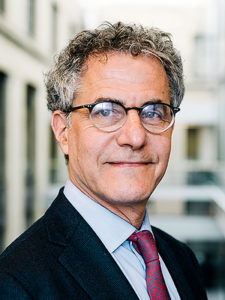Letter from the Dean
Science@MIT Spring 2019 issue

Dear Friends,
This spring, for the first time, we saw a black hole — a hazy ring surrounding a dark void: the singularity! This extraordinary image was captured by a network of radio telescopes scattered across our planet, all pointed at the M87 galaxy and each recording data at a prodigious rate over a four-day viewing period.
Hard drives containing a petabyte of data from each telescope were flown to supercomputers at MIT Haystack Observatory and the Max Planck Institute for Radio Astronomy in Germany. Scientists in four different labs then independently assembled the data using algorithms developed here at MIT. All showed the same result: a dark circle ringed by an ethereal orange glow — the bright shadow of a black hole 6.5 million times as massive as our Sun.
Just like our first discovery of gravitational waves as the product of two black holes colliding, this new discovery once again proves Einstein right. With our algorithms and supercomputers, we are able to detect further direct evidence of the existence of black holes and their influence on plasma and other materials spiraling around their centers at near light speed.
These findings are representative of a truly successful collaboration of disciplines, a partnership that researchers at the School of Science are eager to build upon with the new MIT Schwarzman College of Computing.
We had curiosity-driven questions that needed answers: Could we capture images of black holes? Could we see the effect of their gravity or hear the aftermath of their collisions? Scientific research paired with advances in computation have allowed us to answer these questions — and could likely provide us with answers to many more.
In this issue of Science@MIT, we present how this partnership between computation and science plays out in fields such as brain and cognitive sciences. You can read about MIT’s long history of integrating science, computing, and artificial intelligence (AI). What we know about the basic biology of the brain, including its neural networks, has formed the basis for advances in machine learning, narrowing the gap between natural and artificial intelligence.
In our disciplines like mathematics, we can write algorithms that model natural phenomena and, from these, develop technologies to see if our predictions match reality. In the case of the black hole image, using mathematics, we stitched together eight distinct datasets to create a stellar composite picture. In physics, our knowledge of quantum phenomena brings us ever closer to the creation of a true quantum computer that will outpace any standard supercomputer to date.
This research in physics, mathematics, and brain and cognitive sciences, shapes technology development and advances computation. And, as in most other disciplines here at MIT, our research also requires increased computing power to crunch massive datasets, including those coming out of labs in our Departments of Biology, Chemistry, and Earth, Atmospheric and Planetary Sciences.
For example, you can read about Professor Raffaele Ferrari’s research on climate modeling that gathers huge amounts of data from microphenomena in the circulation of oceans and clouds to improve our predictions on climate change. I am grateful to donors like Audrey Buyrn and her late husband, Alan Phillips, who see the promise of machine learning and data assimilation technologies — and the good they can bring our planet. For more than 10 years, Audrey’s support of the Ally of Nature Fund has allowed faculty members, such as Raffaele, to pursue these fundamental questions in order to make a better world.
In brain and cognitive sciences, Professor Elly Nedivi has studied the genetic differences underlying cellular mechanisms that may lead to neurological disorders, such as bipolar disorder. In a recent study, Elly has shown that the low level of a specific protein in the brain affects neural connections and may lead to an increased risk of developing disease. The sequencing of these variations in genes and the analysis of their expression is now commonplace in the life sciences; but without computers, this would have been an impossible task even 15 years ago. I am thankful that Bill and Linda Young are supporting Elly’s research through the creation of the William R. (1964) & Linda R. Young Professorship Fund. You can read more about Elly’s inspiring science here.
The partnership of scientific exploration with advanced computing is yielding exciting advances here at the School of Science and around the world. Through the support of our inspired alumni and of visionary leaders like Stephen Schwarzman, we can combine the computing expertise of the new college with our school’s unparalleled scientific research to drive new discoveries and change what we know about the world.
Michael Sipser, Dean of MIT School of Science